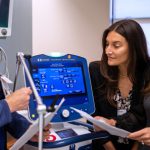 Dr. Zongqi Xia, assistant professor of neurology and biomedical informatics at the University of Pittsburgh School of Medicine, studies multiple sclerosis (MS) at the Pittsburgh Institute for Neurodegenerative Diseases and the Pittsburgh Institute for Multiple Sclerosis Care and Research.
Dr. Zongqi Xia, assistant professor of neurology and biomedical informatics at the University of Pittsburgh School of Medicine, studies multiple sclerosis (MS) at the Pittsburgh Institute for Neurodegenerative Diseases and the Pittsburgh Institute for Multiple Sclerosis Care and Research.
In collaboration with Dr. Daniel Reich at the National Institutes of Health and Dr. Philip De Jager at the Brigham and Women’s Hospital in Boston, he has been studying families of people diagnosed with MS as part of a larger effort known as the Genes and Environment in Multiple Sclerosis (GEMS) project. The goal is to map the sequence of events leading to MS.
In individuals affected by MS, the body’s immune system is turned against itself, injuring the nerves that allow us to feel, see and move. The immune system normally fights infection, but in MS, immune cells from the blood damage the brain and spinal cord over time. A key question is, “Can early detection of MS lead to better outcomes?” Earlier detection of the disease process can help researchers understand what triggers MS and ultimately test ways to prevent the disease.
In a recent study published in the JAMA Neurology, the team focused on family members who didn’t exhibit symptoms, but were deemed at higher or lower risk of developing MS based on their genetic burden and environmental exposure history. The researchers performed a wide range of neurological and neuroimaging tests designed to detect early evidence of MS.
Researchers found potential evidence of abnormal neurological function in higher-risk family members who hadn’t yet developed symptoms of MS. One surprising finding was that participants deemed to be at higher risk for MS had diminished ability to detect vibration in the big toes than those at lower risk.
The finding suggests that diminished vibration sensitivity may be one early indicator of impaired neurological function in individuals at risk for MS, the authors said. However, they caution that additional studies are needed to confirm this finding.
The authors emphasized that before vibration testing can be considered as part of a predictive test for MS, changes in vibration sensitivity over time would need to be studied. The study was limited to women, as women represent a majority of the study participants in the GEMS study.
“While this is an exciting finding, we are still in the early days of learning how to evaluate and monitor individuals at risk for MS such as family members of people with MS,” Dr. Xia said.
The results of this paper, along with those reported in another recent publication from the GEMS study, suggest that characterization of genetic and environmental risk provides promising information toward understanding MS. The research team is moving forward with a long-term study to follow family members over time.
Andrew Papale, Ph.D., is a postdoctoral research associate in the Department of Neurobiology at the University of Pittsburgh School of Medicine









